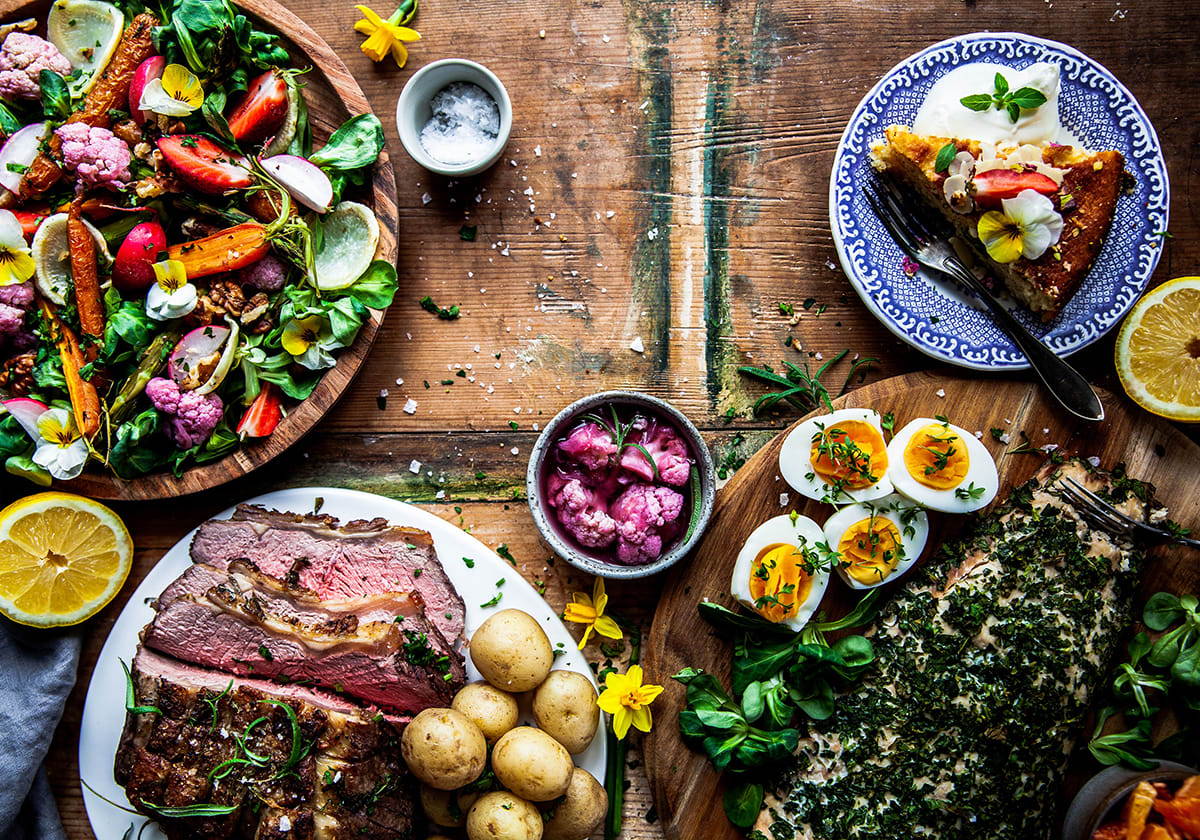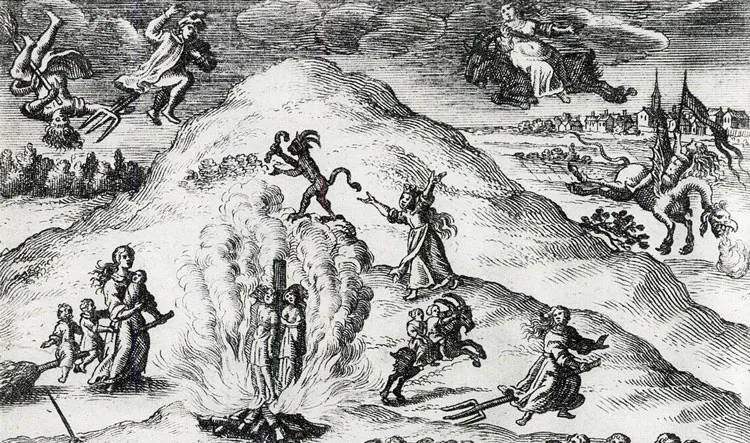We are on Trustpilot
We are rated Excellent, read what our customers are saying
Curious about how the Scandinavians celebrate Easter? Then this guide will give you a lowdown on Scandinavian Easter celebrations, including the delicious foods they indulge in!
Even if you’re a Scandinavian yourself, there are things you might not know…like the Norwegians’ obsession with Easter crime, the Swedes’ love of Easter witches, and the Danes’ tradition of sending rhymes and poetry for Easter!

The Origins of Scandinavian Easter
Modern Scandinavian Easter Traditions

Sweden—Påsk

Denmark—Påske
Gækkebreve (the name ‘gække’ refers to the snowdrop flowers—a sign of spring) are a Danish Easter tradition similar to the Swedish Easter letters, where children (and adults) create elaborate paper cutouts with poems inside. Signed only with dots for the sender's name (as many dots as there are letters in the name), a guessing game ensues as to who made it and the winner gets an Easter egg!
The tradition dates back to the 16th century when it was more like love letters, but containing a riddle and a poem…and sometimes a snowdrop flower!
Apart from that, the traditions are similar to those in Sweden.
Norway—Påske

In Norway many people head off to the mountains for that one last skiing trip of the year, while others take time off to head south and bask in the sun. Notoriously, their favorite snacks to bring along are oranges and chocolate—Kvikk Lunsj bars (more about the oranges in the food section below).
Back in the day, on Easter Sunday, people would hike to the top of the mountains to watch the sunrise. The weather that day was supposed to be an indicator of when summer would arrive and what it would be like weather wise.
These days, Easter Sunday is more about a sumptuous breakfast with pancakes and eggs.
On Good Friday in most Nordic countries, all entertainment used to be forbidden as it was a time to remember the suffering of Christ. While that’s no longer the case, in Norway they’ve removed commercials for regular enterprises to be aired on Good Friday. Instead, they air commercials for charities!
The long weekend is also perfect for reading…and what better to read than crime novels? Bookstores go nuts promoting “Easter crime” novels and TV channels join in with crime series and movies. This dates back to the 1920s when two writers concocted a crime novel that took place around Easter time.
Finland—Pääsiäinen
Scandinavian Easter Food
We don’t produce blue cheese because the green mold spreads very easily.”
Now, we’re getting to the crux of the matter: food. Easter wouldn’t be Easter without the food in Scandinavia. And while there are similarities among the different Scandinavian countries when it comes to Easter food, there are also some differences.
Sweden—Påskmat
Fish and eggs are in focus for most people when serving Easter lunch, or dinner.
Various forms of pickled herring, smoked and cured salmon, accompanied by potatoes and hard boiled eggs. This might be followed by meat dishes, such as meatballs, and cheese such as Västerbottensost. Usually there is also rye/dark bread to accompany the meal and some schnapps!
Some Swedes also enjoy dishes made from lamb, which is an old Jewish tradition, as well as a symbol of Jesus being sacrificed (and while Easter today among Christians focus on the death and rebirth of Jesus, originally they had the same traditions as the Jews, also celebrating leaving the Jews leaving Egypt, so the two traditions intermingled).
While there might not be traditional Easter dessert, marzipan figures (eggs and bunnies), as well as chocolate eggs (filled with marzipan, marshmallow, nuts, licorice, or plain chocolate) feature heavily among the treats eaten for Easter.
Here the focus is instead on the traditional Easter smörgåsbord with herring, salmon, lamb, eggs and marzipan being the biggest stars. And of course with an occasional shot of aquavit. Swedes also like to drink påskmust—a form of soda similar to ginger beer. The one sold in the shops is made with malt and hops, but we scored an old recipe for making your own påskmust (found at the bottom of this blog).
Denmark—Påskemad
The food eaten in Denmark over Easter is similar to the food eaten in Sweden, though interestingly they have some old traditions that aren’t as much adhered to anymore. On Maundy Thursday you ate cabbage soup made with seven to nine different kinds of cabbage and mutton or pork (it was thought to be nutritious and guarantee good health).
On Easter Saturday the Danes liked to do their spring clean for the year and ate “dirty eggs” (eggs with a mustard sauce).
For the Sunday Easter lunch (påskefrokost), that is still very much happening, locals prepare lamb, boiled eggs, herring and other kinds of fish such as salmon. It is quite similar to the Swedish feast but of course the Danes also tend to do what they do best- put their food on bread. It is a law of nature that you cannot get Danes to eat a buffet without turning it into a veritable smørrebrød-feast, where every dish is eaten with a specific type of bread and specific trimmings. It is important to understand that white bread is for salmon and shrimp and dark rye bread for herring and anything with meat.
Easter beer is a popular drink for Easter, very similar to Christmas beer.
Norway—Påskematen
In Norway the focus is mainly on two food items: lambs and….oranges. Oh and eggs, so make that three!
As already mentioned, when heading to their “hytte” in the mountains to go skiing, the Norwegians like to pack Kvikk Lunsj bars (a chocolate produced since the early 1900s), and oranges. While it might seem bizarre to eat oranges around Easter (they’re out of season), it’s likely because back in the day the oceans remained frozen up until around Easter time. So that’s when ships would return with exotic products, like oranges. These days, about 20 millions of oranges are consumed for Easter every year in Norway! (And this is a country with a population of only about five million people!).
Some Norwegians also like to bring dried or smoked lamb with them to their hyttes in the mountains. More often than not, a lamb roast is also served on Easter Sunday.
Rakfisk is another Easter favorite. It’s a fermented fish dish made from trout. Rakfisk is traditionally served sliced on flatbrød or lefse and topped with raw onion, boiled potato, and sour cream.
Lefse is a type of bread made from potatoes and flour. It is often served as a roll together with, for example, jam, cheese, sugar, or cinnamon. As mentioned previously, some Norweigians like a big breakfast for Easter Sunday, usually a breakfast centered around eggs.
Finland—Päsiäisruoka
The Scandinavian Obsession with Easter Eggs
Why do Scandinavians and other people in the West consume so many eggs during Easter? Well, apart from being a symbol for spring and fertility, you weren't allowed eggs during Lent. So if you adhered to the rules of Lent (fasting for 40 day), you didn’t eat any eggs. Which meant that when Easter rolled around there were a lot of eggs on hand! The egg was also seen as a symbol of Jesus’ resurrection as it carried a new life within it.
In the Middle Ages, people carried baskets of decorated eggs to church to be blessed by the priest. Coloring served to highlight the eggs' symbolic importance. These painted eggs were then given as gifts to loved ones and other important figures. Later in history, artificial eggs made of glass and porcelain became popular. Today, it is usually a paper egg filled with candy that we give away, but the tradition of decorating boiled eggs by painting them still lives on as a craft in Scandinavia.
It is believed that people in the Western World eat six million eggs per hour just on Easter Saturday and in Sweden 4,000 tonnes of eggs are eaten during the week of Easter.
The Golden Egg
Recipes
Mämmi—Finnish Rye Porridge
Påskmust—Swedish Non-Alcoholic Easter Beer
The Lazy Person's Guide to Scandinavian Easter